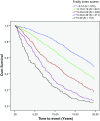Development and validation of a frailty index in the Longitudinal Aging Study Amsterdam - PubMed (original) (raw)
Development and validation of a frailty index in the Longitudinal Aging Study Amsterdam
Emiel O Hoogendijk et al. Aging Clin Exp Res. 2017 Oct.
Abstract
Background: Frailty is a state of increased vulnerability to adverse outcomes. The frailty index (FI), defined by the deficit accumulation approach, is a sensitive instrument to measure levels of frailty, and therefore important for longitudinal studies of aging.
Aims: To develop an FI in the Longitudinal Aging Study Amsterdam (LASA), and to examine the predictive validity of this FI for 19-year mortality.
Methods: LASA is an ongoing study among Dutch older adults, based on a nationally representative sample. A 32-item FI (LASA-FI) was developed at the second LASA measurement wave (1995-1996) among 2218 people aged 57-88 years. An FI score between 0 and 1 was calculated for each individual. The LASA-FI included health deficits from the physical, mental and cognitive domain and can be constructed for most LASA measurement waves. Associations with 19-year mortality were assessed using Kaplan-Meier curves and Cox proportional hazards models.
Results: The mean LASA-FI score was 0.19 (SD = 0.12), with a 99% upper limit of 0.53. Scores were higher in women than men (women = 0.20, SD = 0.13 vs. men = 0.17, SD = 0.11, p < 0.001). The average age-related increase in the log-transformed LASA-FI score was 3.5% per year. In a model adjusted for age and sex, the FI score was significantly associated with 19-year all-cause mortality (HR per 0.01 = 1.03, 95% CI 1.03-1.04, p < 0.001).
Discussion/conclusions: The key characteristics of the LASA-FI were in line with findings from previous FI studies in population-based samples of older people. The LASA-FI score was associated with mortality and may serve as an internal and external reference value.
Keywords: Deficit accumulation; Frail elderly; Frailty index; Longitudinal study; Mortality.
Conflict of interest statement
The authors declare that they have no conflict of interest.
Figures
Fig. 1
Distribution of the frailty index at baseline (N = 2218)
Fig. 2
Average frailty index score by sex and age
Fig. 3
Kaplan–Meier curves according to frailty index score: proportions of people who survived plotted against time
Similar articles
- Tracking changes in frailty throughout later life: results from a 17-year longitudinal study in the Netherlands.
Hoogendijk EO, Rockwood K, Theou O, Armstrong JJ, Onwuteaka-Philipsen BD, Deeg DJH, Huisman M. Hoogendijk EO, et al. Age Ageing. 2018 Sep 1;47(5):727-733. doi: 10.1093/ageing/afy081. Age Ageing. 2018. PMID: 29788032 - A frailty index based on laboratory deficits in community-dwelling men predicted their risk of adverse health outcomes.
Blodgett JM, Theou O, Howlett SE, Wu FC, Rockwood K. Blodgett JM, et al. Age Ageing. 2016 Jul;45(4):463-8. doi: 10.1093/ageing/afw054. Epub 2016 Apr 13. Age Ageing. 2016. PMID: 27076524 - Predictive validity of two frailty tools for mortality in Chinese nursing home residents: frailty index based on common laboratory tests (FI-Lab) versus FRAIL-NH.
Yang M, Zhuo Y, Hu X, Xie L. Yang M, et al. Aging Clin Exp Res. 2018 Dec;30(12):1445-1452. doi: 10.1007/s40520-018-1041-7. Epub 2018 Sep 26. Aging Clin Exp Res. 2018. PMID: 30259498 - Frailty index as a predictor of mortality: a systematic review and meta-analysis.
Kojima G, Iliffe S, Walters K. Kojima G, et al. Age Ageing. 2018 Mar 1;47(2):193-200. doi: 10.1093/ageing/afx162. Age Ageing. 2018. PMID: 29040347 - Aging, frailty and complex networks.
Mitnitski AB, Rutenberg AD, Farrell S, Rockwood K. Mitnitski AB, et al. Biogerontology. 2017 Aug;18(4):433-446. doi: 10.1007/s10522-017-9684-x. Epub 2017 Mar 2. Biogerontology. 2017. PMID: 28255823 Review.
Cited by
- The phenotypic and genotypic association of grip strength with frailty, physical performance and functional limitations over time in older adults.
Stringa N, van Schoor NM, Hoogendijk EO, Milaneschi Y, Huisman M. Stringa N, et al. Age Ageing. 2023 Oct 2;52(10):afad189. doi: 10.1093/ageing/afad189. Age Ageing. 2023. PMID: 37847794 Free PMC article. - Older persons are frailer after an emergency care visit to the out-of-hours general practitioner cooperative in the Netherlands: a cross-sectional descriptive TOPICS-MDS study.
Bloemhoff A, Schoon Y, Smulders K, Akkermans R, Vloet LCM, van den Berg K, Berben SAA; TOPICS-MDS Consortium. Bloemhoff A, et al. BMC Fam Pract. 2020 Aug 20;21(1):171. doi: 10.1186/s12875-020-01220-y. BMC Fam Pract. 2020. PMID: 32819281 Free PMC article. - A Simplified Frailty Index Predicts Mortality in Older Adults in Beijing.
Zhang L, Ji T, Sun F, Li Y, Tang Z, Ma L. Zhang L, et al. Risk Manag Healthc Policy. 2021 Dec 3;14:4867-4873. doi: 10.2147/RMHP.S302354. eCollection 2021. Risk Manag Healthc Policy. 2021. PMID: 34887689 Free PMC article. - Application of MFI-5 in severe complications and unfavorable outcomes after radical resection of colorectal cancer.
Huang L, Li Z, Jian M, Wu X, Chen H, Qin H, Li Z, Song S, Xie Y, Chen R. Huang L, et al. World J Surg Oncol. 2023 Sep 26;21(1):307. doi: 10.1186/s12957-023-03186-4. World J Surg Oncol. 2023. PMID: 37752577 Free PMC article. - Racial, Ethnic, and Socioeconomic Differences in a Deficit Accumulation Frailty Index in the Multiethnic Cohort Study.
Wu AH, Setiawan VW, Stram DO, Crimmins EM, Tseng CC, Lim U, Park SY, White KK, Cheng I, Haiman CA, Wilkens LR, Le Marchand L. Wu AH, et al. J Gerontol A Biol Sci Med Sci. 2023 Jul 8;78(7):1246-1257. doi: 10.1093/gerona/glac216. J Gerontol A Biol Sci Med Sci. 2023. PMID: 36255109 Free PMC article.
References
Publication types
MeSH terms
LinkOut - more resources
Full Text Sources
Other Literature Sources


